By Scott Smith | Contributing Editor
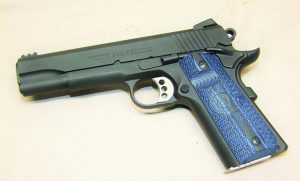
Colt’s Competition Pistol in 9mm, is practically perfect for IDPA, USPSA, and three gun competition right out of the box.
Today manufacturers are offering handguns to meet shooters needs for competition and practice. We find old school pistols such as 1911s being offered in 9mm for personal protection and competition and numerous “air guns” that look and feel like their centerfire counterparts for practice. It is good to see time tested names like Colt (Phone: 800-962-2658; Online: colt.com) and Sig Sauer (Phone: 603-610-3000; Online: sigsauer.com) leading the way.
At the 2016 SHOT Show, Colt debuted their time tested and battle proven 1911 in 9mm; the Colt Competition Pistol. This pistol is built for action shooting from its nine round capacity to the adjustable Novak sights to the undercut frame and beavertail grip safety. It seems Colt built this pistol for IDPA’s ESP Division where 9mm is king. It will also serve well in USPSA’s Limited 10 or Single Stack Divisions, but you give up scoring in 9mm; so you might want the 45ACP version.
When I opened the box the first thing I noticed was the custom VZ Grips. These G10 grips have the Colt logo molded into the highly textured grips. The cut away on the magazine release side of the grips places your thumb on the release every time you need to do a mag change. This feature is a big aid when indexing the pistol in the dark and low light.
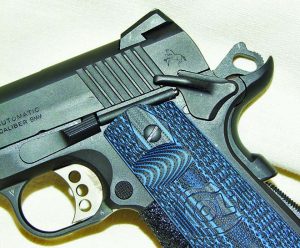
Close-up of the extended single side safety and custom Colt VZ Grips which are both functional and good looking.
The next item one notices is the blue Novak fiber optic front sight. While this sight is Colt blue, I understand why Colt installed the blue fiber optic front, in keeping with Colt’s traditional blue color. While the sight was visible in bright sunlight, it is very hard to see in low light. I installed a red fiber the second trip to the range. I wanted to see the sight in all conditions when running this 1911 in competition. I will say Colt did have the adjustable Novak rear sight set for point of aim/point of impact right out of the box. There was little variance with any weight bullet. Over the years, contrary to some folk’s opinions, duty loads performance varies, very little where point of aim/impact are at twenty five yards is concerned. You will find an adjustable sight help, if you shoot true low power target loads.
One of the complaints about Colt’s 1911’s were the “down swept” beavertail grip safeties. Thankfully they now install a proper up swept speed bump grip safety that was perfectly fit. You will also find an extended single side thumb safety for ease of manipulation.
Fit and finish of the pistol is what one would expect from Colt. The matte blue finish was flawless and even; it would only have been better if it was the old school high polish bluing of old. Movement and fit of the slide on the frame was like a hot knife through butter. I could not feel any roughness when riding the slide slowly into battery. This is a sign that Colt still builds their 1911s properly.
Two features of this pistol that I liked are the short recoil plug. This allows you to clear a jam off of a shelf or door frame is needed and back in days of old when I was issued a 1911 it allows you to pinch check the condition of the firearm. To the entire current crop of RO’s do not have a stroke, Uncle Sam taught thousands of soldiers to do this without having traumatic amputations of the forefinger of our left hand.
To help mitigate and control recoil, the rear of the trigger guard is scalloped. In conjunction with the nicely fitted speed bump beavertail grip safety the shooter gets a higher grip on the pistol. This lowers the bore axis in the hand, which reduces muzzle flip. The new dual recoil spring system Colt is using further mitigates felt and actual recoil.
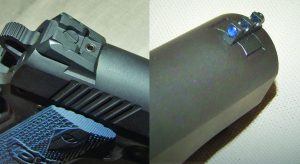
Novak’s adjustable rear sight and blue fiber optic sight are standard features on the Competition Pistol.
Since the weather was cooperating I was able to make several trips to the range with the Competition Pistol. The 1911’s first trip to the range was just to see how it shot. As is my standard practice I took a mixed bag of 9mm ammunition with me. Head stamps ranged from Black Hills to Wolf and only the good Lord knows what all the bullet weights were. I loaded the factory magazines and magazines from Wilson, Dawson Precision and Tripp Research. One hundred fifty rounds plus later the Competition Pistol was still putting rounds down range without a hiccup. This 1911 was consistently keeping all rounds in the “C Zone” at 25 yards regardless of the bullet make or weight.
The second venture to the range I had swapped the blue fiber optic for a red one and packed Black Hills (Phone: 605-348-5150; Online: black-hills.com) 124-grain hollow points and 115-grain full metal jacket. I have found these two loads to be two of the most accurate loads on the market. I did bring out an additional factory load to see if it would cause issues with the dual recoil spring system, a couple factory 147-grain subsonic loads. Some of the dual sprung polymer pistols have had issues with subsonic loads, so I wanted to test the Colt with them.
Accuracy testing of the Competition Pistol was done at 25 yards, shooting five-shot groups using my MTM Site-In-Clean (Phone: 937-890-7461Online: mtmcase-gard.com). While this rest is built for work with rifles, I have found it works well with most handguns giving consistent support to the frame. For targets I used Birchwood Casey’s (Phone: 800-746-6862; Online: birchwoodcasey.com) Dirty Bird 12X18 IPSC Bad Guy Target. These targets are a true small USPSA to make you aim small and hits are easily seen at 25 yards.
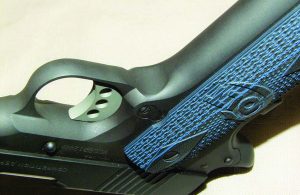
Undercutting the frame allows shooters to get a higher grip on the Competition Pistol to help reduce felt recoil.
I went out to the range early so the sweltering summer temperatures would not affect the shooter. It is hard to shoot accurately when you are blinded by sweat. The Colt Competition Pistol performed like a 1911 should, groups hovered at two and a half inches; give or take a smidge. This is as good as I can make pistol shoot. I have no doubt that this pistol is capable of shooting tighter groups by someone with younger eyes and a gentler trigger squeeze. However, for action pistol shooting and most any other application this pistol is ready to run. I attribute this consistent performance to Black Hills’ quality ammunition and to Colt properly fitting the barrel.
I am pleased to report the Colt never missed a beat with the Lawman load. This CCI offering is gentle shooting and with very little recoil is ideal for IDPA, USPSA, and three gun competition. I have only seen a few pieces of steel require more than one shot to take them down.
Overall I found the Colt Competition Pistol to be an excellent 1911. With Colt marketing it for competition, I would like to have seen them add a magazine well and extended “tactical” magazine release not the GI size that was installed. These are features that a competition pistol beg to have and they would not vastly increase the $949 MSRP. As it stands, I can tell you I was impressed enough with the Colt Competition Pistol that I sent them a check to keep this 1911.
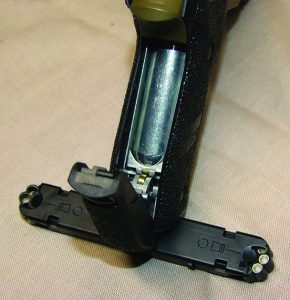
The CO2 cartridge fits in the rear of Sig’s P226 Pellet pistol and the magazine holds 16 pellets to keep you shooting longer.
When foul weather hits, if you have a safe area you can set up a range and shoot your Sig Sauer P226. Well, you can shoot a .177 pellet, CO2 powered version of the P226 that feels just like your full size model. Before you gasp and blow off the idea, I will be skeptical for you.
Sig’s P226 .177 sixteen shot pellet pistol ($89.99) has the same controls as my P226 9mm, fits the same holsters and at fifteen feet is just as wicked accurate. While you do not get the report and recoil of a 9mm, you have the same feel in your hand. This allows you to practice your draws and target engagements since Sig offers a complete target system. Two things are different on the pellet pistol from the centerfire pistol; the safety is not a spring loaded decocking lever and the slide will not lock back. These safety features are a minor inconvenience to deal with.
When the big brown truck delivered the CO2 version of the 226 and targets I was pleased to see there was a Resetting Quad Shooting Gallery ($69.99), a “Texas Star” ($79.99), Air Reflex ($27.99) and a Dual Spinner ($21.99). The star and spinner are designed to stick in the ground so they will not work in the garage, but the Resetting Quad Shooting Gallery is ideal for indoor use (again if you have a safe area). I have been able to test the spinners and star at my gun club. The star does not spin nearly as fast as its competition version but for practice it is a lot easier to set-up and transport than an armored steel centerfire model.
When shooting the P226 pellet pistol you will know when the CO2 cartridge is running out; the accuracy rapidly drops off and the slide does not cycle. I found this to be around sixty shots with the 12 gram cartridge, with the 25 or 40 gram versions I am sure this will easily double or triple. When the cartridge is full your will easily knock down the “steel” targets and punch holes in a cardboard IPSC target. The steel not reacting is one of the first clues you need to chance CO2 cartridges.
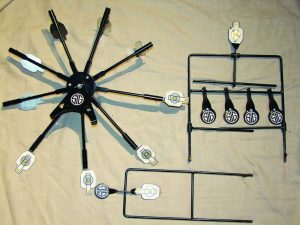
This is a good view of Sig’s reactive pellet gun “steel”; Texas Star, spinner and resettable 4 target plate rack. All will challenge you.
The P226-pellet pistol not only allows one to practice basic shooting drills, it also forces you to work on trigger control. The fire controls are not as crisp as a quality pistol so they force you to work on the basics. This pellet gun has helped make me a better shooter because of this. The small “steel” targets also have no room for error for proper shot placement; forcing you to stare down the front sight on target. Another bonus of the pellet gun is you can do dry fire drills without fear of damaging the engagement surfaces of your centerfire pistol. In all the years I have fired Daisy air guns and now Sig Sauer’s I have not had a pellet gun break from dry firing one.
A big bonus of true size replica handguns is being able to teach a non-shooter to shoot without fear of recoil or muzzle noise. While safety glasses must be worn to protect your eyes, novices will not develop the dreaded flinch from the bang and recoil of a centerfire firearm. The cost per shot is substantially less with a CO2 powered true copy gun like this Sig P226 .177 caliber versus a 9mm or 22LR.
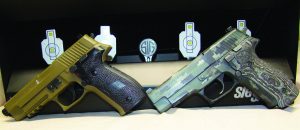
You can see a 9mm P226(R) with the P226 pellet gun in front of Sig’s bullet trap target system.
While these pellet guns allow shooters to practice the basics of shooting, they allow us to do something else; have fun. When a lot of folks get out their 9mm P226 they forget, shooting is fun. Pellet guns allow us to put fun back into practice. When was the last time you plinked at a beer can with your 9mm or 22LR, would you do it with a .177 pellet gun? I tied one to a string to hang it from the seven yard target frame at the club and had a ball making it dance with each shot. Not only was it fun, but it teaches you to track the pistol on a moving target. Shooting hanging bowling pins is about as close as you get with a centerfire handgun; but they lack that twang/clang of a pellet hitting an aluminum can.
Manufacturers are building products to match the needs of consumers. As you can see Colt is building a solid 1911 in the guise of the Colt Competition Pistol and Sig Sauer offering CO2 powered pellet pistols to mimic their centerfire handguns. Consumers want pistols like the Colt that allow them to shoot a number of action pistol sports and they need ways to get trigger time when the weather is less than hospitable. That is where true size/feel copies like the Sig Sauer Air P226 fill that niche.
I am glad to see manufacturers listening to the consumer. This becomes a win-win for us all. If we wish to keep having The Right to Keep and Bear Arms, remember to vote in November; and NOT for Mrs. Bill Clinton. Mr. Trump may not be the first choice of many folks, but voting for anyone else is voting for Mrs. Bill Clinton. I for one do not agree with some of Mr. Trump’s ideas, but he and his family are supporters of Veterans, The Second Amendment and our country. Mrs. Bill Clinton is not. After you vote; get out to the range to get ready for deer season. Remember to be safe, shoot straight and have fun.



